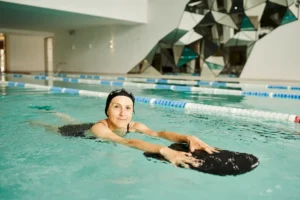While highly effective in restoring shoulder function, total shoulder replacement necessitates a well-planned rehabilitation strategy to ensure a successful recovery. Our focus today is to provide you with comprehensive tips and techniques to navigate your post-total shoulder replacement rehabilitation journey effectively.
Understanding Post-Total Shoulder Replacement Rehabilitation
Post-total shoulder replacement surgery marks the beginning of a critical recovery phase. The rehabilitation process is vital for regaining strength, flexibility, and function in the shoulder. It’s essential to understand that each individual’s recovery journey is unique, but some common milestones and techniques can aid in smoother rehabilitation.
Phase 1: Initial Recovery and Pain Management
The first phase of post-total shoulder replacement rehabilitation focuses on managing pain and swelling. It’s crucial to follow your doctor’s advice regarding medication, ice therapy, and rest. Gentle movements may be introduced to prevent stiffness, but it’s important not to rush this phase. Pain management is a key aspect of this early stage, as it sets the foundation for more active rehabilitation exercises.
Phase 2: Gradual Mobilization and Strengthening
As you progress in your post-total shoulder replacement recovery, gentle exercises become integral. These exercises, often guided by a physical therapist, aim to gradually increase the range of motion and strengthen the shoulder muscles. Techniques like assisted stretching, light resistance exercises, and mobility drills are commonly employed. It’s important to progress at a pace that doesn’t aggravate the shoulder, keeping in close communication with your healthcare provider.
Phase 3: Advanced Strengthening and Functional Training
The advanced phase of post-total shoulder replacement rehabilitation involves more strenuous exercises and functional training. This stage is designed to restore your shoulder’s strength to pre-surgery levels, or even better. Exercises become more dynamic and incorporate real-life activities. However, it’s crucial to remain patient and consistent, as overexertion can lead to setbacks.
Long-Term Maintenance and Care
Post-total shoulder replacement rehabilitation doesn’t end when you regain full shoulder function. Long-term maintenance is crucial for preserving the benefits of the surgery. This involves regular exercises, maintaining a healthy lifestyle, and periodic check-ups with your orthopedic surgeon. Here’s a detailed look at how to ensure lasting benefits:
- Regular Exercises: Even after full recovery, incorporating a routine of specific exercises is crucial. These exercises, which might include range-of-motion stretches, strengthening exercises, and functional drills, should be continued to maintain muscle strength and joint flexibility. Consistency is key; a regular, balanced exercise regimen helps prevent stiffness and maintains the mobility of the shoulder joint.
- Healthy Lifestyle Choices: Adopting a healthy lifestyle significantly contributes to long-term joint health. This includes maintaining a balanced diet rich in nutrients that support bone and muscle health, such as calcium, vitamin D, and protein. Staying hydrated and avoiding habits like smoking or excessive alcohol consumption also play a vital role in overall health and recovery.
- Weight Management: Keeping a healthy weight reduces unnecessary stress on your shoulder and other joints. Excess weight can strain the shoulder, potentially leading to discomfort or complications. A combination of diet and exercise is the best approach to maintaining a healthy weight.
- Periodic Check-Ups with Your Orthopedic Surgeon: Regular follow-ups with your orthopedic surgeon are essential. These check-ups allow your doctor to monitor the long-term health of your shoulder joint, address any concerns, and adjust care plans as needed. They also provide an opportunity to discuss any new activities or exercises you wish to undertake.
- Ergonomic Adjustments: Making ergonomic adjustments in your daily life can also aid in maintaining shoulder health. This might include setting up a work environment that reduces strain on your shoulders, learning proper lifting techniques, and avoiding repetitive stress on the joint.
- Stress Management and Mental Health: Chronic stress can negatively impact physical health, including recovery and maintenance post-surgery. Engaging in stress-reducing activities like meditation, yoga, or other relaxing hobbies can be beneficial. Moreover, maintaining a positive mental outlook can aid in overall well-being and recovery.
By focusing on these long-term strategies, individuals who have undergone post-total shoulder replacement can not only preserve the benefits of their surgery but also enhance their overall quality of life. It’s about building a sustainable, healthy routine that supports both the physical and mental aspects of recovery and maintenance.
Key Steps for Enhanced Recovery
Rehabilitation following a post-total shoulder replacement is a critical phase, not just for healing, but also for regaining the full function of your shoulder. This journey, while demanding patience and dedication, can be significantly optimized with the right approach and techniques. Here, we explore key steps to ensure an enhanced recovery, helping you return to your daily activities with confidence and achieve optimal shoulder function.
- Follow a Structured Rehabilitation Plan: Your healthcare provider will design a rehabilitation plan tailored to your specific needs. Adhering to this plan is crucial. It typically includes a series of exercises and activities aimed at gradually improving shoulder mobility, strength, and function.
- Consistent Physical Therapy: Engage in regular sessions with a physical therapist. These professionals guide you through exercises correctly, ensuring you’re not only doing them effectively but also safely, to avoid any setbacks.
- Pain Management: Proper pain management is essential, especially in the early stages of recovery. Utilize prescribed medications, ice therapy, and rest to manage pain and swelling. This not only helps in comfort but also in facilitating more effective rehabilitation exercises.
- Gradual Progression in Activities: Gradually increase the intensity and range of your activities as recommended by your therapist. Pushing too hard too soon can be detrimental, but steady progression is key to rebuilding strength and mobility.
- Incorporate Stretching and Strengthening Exercises: As your recovery progresses, incorporate more stretching and strengthening exercises. These are critical for restoring the shoulder’s range of motion and building the muscle strength needed for daily activities.
- Maintain a Healthy Lifestyle: A balanced diet, adequate hydration, and proper rest can significantly impact your recovery. Nutritional support is vital for tissue repair and overall health, while sufficient sleep aids in the body’s natural healing process.
Remember, each step in your rehabilitation, no matter how small it seems, is a stride toward regaining the full functionality of your shoulder. By diligently following these steps, you ensure a robust and efficient recovery process, paving the way to resume your daily activities with renewed strength and confidence.





